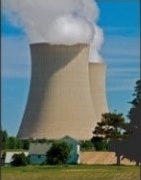By Laura Hurley
Between now and 2050, the International Energy Agency projects that more than $100 trillion will be spent on building net-zero energy infrastructure globally. Yet every single one of these projects runs the risk of higher-than-expected construction costs or time delays. Newer technologies introduced in the past decade, such as hydrogen or geothermal energy, are even more difficult to evaluate as government agencies, energy developers, utilities, investors, and other stakeholders decide which sustainable energy systems are best for future projects.
In a new state-of-the-art study, published in the journal Energy Research & Social Science, researchers at the Boston University Institute for Global Sustainability (IGS) found that runaway construction costs and delayed timelines stymie many energy projects. In fact, the average project costs 40% more than expected for construction and takes almost two years longer than planned, as the study showed.
Nuclear power plants are the worst offenders, with an average construction cost overrun typically twice as much as expected or more, and the most extreme time delays. To be exact, the average nuclear power plant has a construction cost overrun of 102.5% and ends up costing $1.56 billion more than expected.
Looking at newer net-zero options reveals higher risk as well. Hydrogen infrastructure and carbon capture and storage both exhibit significant average time and cost overruns for construction, along with thermal power plants relying on natural gas, calling into question whether these can be scaled up quickly to meet emission reduction goals for climate mitigation.
“Worryingly, these findings raise a legitimate red flag concerning efforts to substantially push forward a hydrogen economy,” says Benjamin Sovacool, lead and first author of the study, director of IGS, and professor of earth and environment.
By contrast, solar energy and electricity grid transmission projects have the best construction track record and are often completed ahead of schedule or below expected cost. Wind farms also performed favorably in the financial risk assessment.
For Sovacool, the evidence is clear: “Low-carbon sources of energy such as wind and solar not only have huge climatic and energy security benefits, but also financial advantages related to less construction risk and less chance of delays,” he says. “It’s further evidence that such technologies have an array of underrated and underappreciated social and economic value.”
Using an original dataset significantly larger and more comprehensive than existing sources, the study provides the most rigorous comparative analysis of construction cost overrun risks and time delays for energy infrastructure projects globally.
[…]
Read more.




